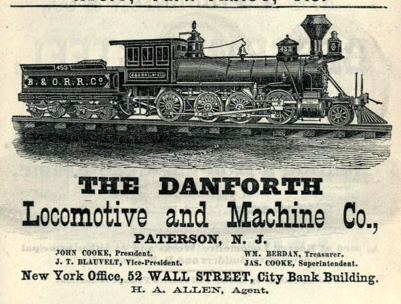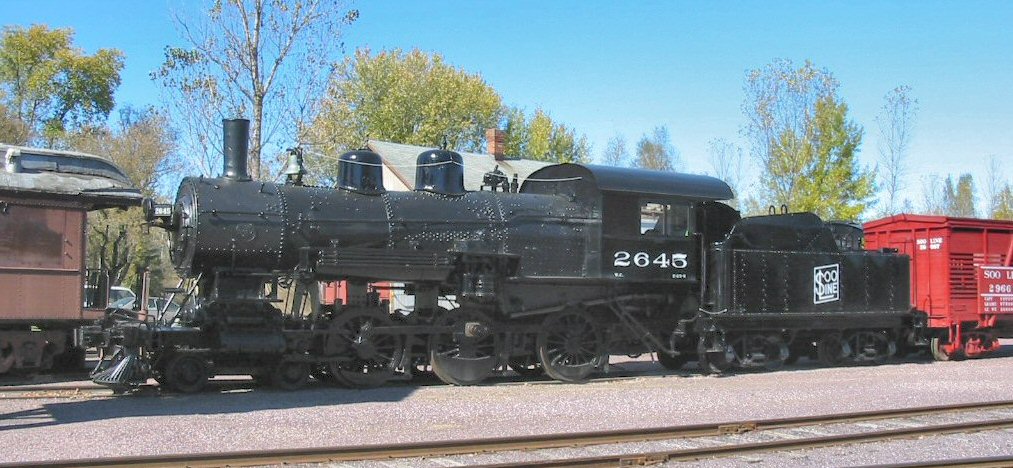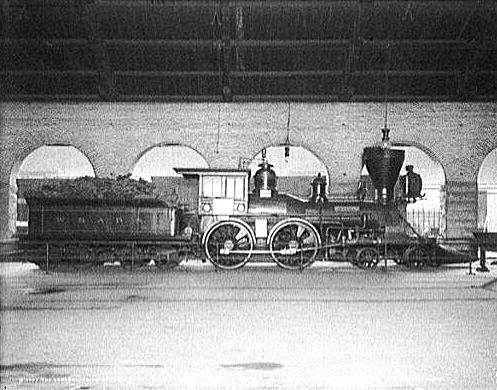|
ALCO
The American Locomotive Company (often shortened to ALCO, ALCo or Alco) was an American manufacturer of locomotives, diesel generators, steel, and tanks that operated from 1901 to 1969. The company was formed by the merger of seven smaller locomotive manufacturers and Schenectady Locomotive Engine Manufactory of Schenectady, New York. A subsidiary, American Locomotive Automobile Company, designed and manufactured automobiles under the Alco brand from 1905 to 1913. ALCO also produced nuclear reactors from 1954 to 1962. The company changed its name to Alco Products, Incorporated in 1955. In 1964, the Worthington Corporation acquired the company. The company went out of business in 1969. The ALCO name is currently being used by Fairbanks Morse Engine for their FM, ALCO line. Foundation and early history The company was created in 1901 from the merger of seven smaller locomotive manufacturers with Schenectady Locomotive Engine Manufactory of Schenectady, New York: * Brooks Loc ... [...More Info...] [...Related Items...] OR: [Wikipedia] [Google] [Baidu] |
Montreal Locomotive Works
Montreal Locomotive Works (MLW) was a Canadian railway locomotive manufacturer which existed under several names from 1883 to 1985, producing both steam and diesel locomotives. For a number of years it was a subsidiary of the American Locomotive Company. MLW's headquarters and manufacturing facilities were located in Montreal, Quebec. Early history The Locomotive and Machine Company of Montreal Limited was created in 1883, producing primarily for the growing domestic market—notably the Canadian Pacific Railway, the Grand Trunk Railway, the Intercolonial Railway and, after 1922, the Canadian National Railway. Purchase by Alco In 1901, the American Locomotive Company (Alco) headquartered in Schenectady, New York, was formed by the merger of several struggling locomotive manufacturers. Alco purchased the Locomotive & Machine Company of Montreal in 1904 to tap into the Canadian market with its emerging designs. The Montreal subsidiary was renamed Montreal Locomotive Works ( ... [...More Info...] [...Related Items...] OR: [Wikipedia] [Google] [Baidu] |
Pittsburgh, Pennsylvania
Pittsburgh ( ) is a city in the Commonwealth of Pennsylvania, United States, and the county seat of Allegheny County. It is the most populous city in both Allegheny County and Western Pennsylvania, the second-most populous city in Pennsylvania behind Philadelphia, and the 68th-largest city in the U.S. with a population of 302,971 as of the 2020 census. The city anchors the Pittsburgh metropolitan area of Western Pennsylvania; its population of 2.37 million is the largest in both the Ohio Valley and Appalachia, the second-largest in Pennsylvania, and the 27th-largest in the U.S. It is the principal city of the greater Pittsburgh–New Castle–Weirton combined statistical area that extends into Ohio and West Virginia. Pittsburgh is located in southwest Pennsylvania at the confluence of the Allegheny River and the Monongahela River, which combine to form the Ohio River. Pittsburgh is known both as "the Steel City" for its more than 300 steel-related businesses and ... [...More Info...] [...Related Items...] OR: [Wikipedia] [Google] [Baidu] |
Worthington Corporation
The Worthington Corporation was a diversified American manufacturer that had its roots in Worthington and Baker, a steam pump manufacturer founded in 1845. In 1967 it merged with Studebaker and Wagner Electric to form Studebaker-Worthington. This company was in turn acquired by McGraw-Edison in 1979. Worthington Pump Works (1845–1899) Worthington and Baker, manufacturers of hydraulic machinery such as steam pumps and meters, was founded by Henry R Worthington and William H. Baker. Worthington was the inventor of the direct acting steam pump. The first foundry was near the Brooklyn Navy Yard. In 1854 the partners moved to Van Brunt Street in Brooklyn. The partnership was dissolved around 1860 when Baker died. A new partnership called Henry R. Worthington, or Worthington Hydraulic Pump Works, was formed in 1862. The United States Navy used Worthington pumps to pump: boiler feed water, bilge water, fire fighting, and general services (https://www.asme.org/about-asme/engineeri ... [...More Info...] [...Related Items...] OR: [Wikipedia] [Google] [Baidu] |
Schenectady Locomotive Works
The Schenectady Locomotive Works built railroad locomotives from its founding in 1848 through its merger into American Locomotive Company (ALCO) in 1901. After the 1901 merger, ALCO made the Schenectady plant its headquarters in Schenectady, New York Schenectady () is a city in Schenectady County, New York, United States, of which it is the county seat. As of the 2020 census, the city's population of 67,047 made it the state's ninth-largest city by population. The city is in eastern New Yo .... One of the better-known locomotives to come out of the Schenectady shops was Central Pacific Railroad type 4-4-0 No. 60, the ''Jupiter (locomotive), Jupiter'' (built in September 1868), one of two steam locomotives to take part in the "Golden Spike Ceremony" to celebrate the completion of the First transcontinental railroad. Although the original was scrapped in 1909, a full-scale, operating replica was completed in 1979, and now is part of an operational display at the Golden Spike ... [...More Info...] [...Related Items...] OR: [Wikipedia] [Google] [Baidu] |
Cooke Locomotive & Machine Works
The Cooke Locomotive and Machine Works, located in Paterson, New Jersey, manufactured steam railroad locomotives from 1852 until it was merged with seven other manufacturers to form American Locomotive Company (ALCO) in 1901. History The firm was established in 1852 by former Rogers Locomotive and Machine Works superintendent (and son-in-law of William Swinburne of Swinburne, Smith and Company) John Cooke and former Montreal resident Charles Danforth as the Danforth, Cooke, and Company, as a manufacturer of steam locomotives as well as cotton machinery. The company was renamed Danforth Locomotive and Machine Company in 1865, with Danforth serving as president until 1871, four years before his death in 1875. Cooke succeeded Danforth as president in 1871, continuing in such capacity until his own death in 1882, after which Cooke's sons, John, Frederick, and Charles reorganized the firm as the Cooke Locomotive and Machine Works, and continued operating the company as such until ... [...More Info...] [...Related Items...] OR: [Wikipedia] [Google] [Baidu] |
Brooks Locomotive Works
The Brooks Locomotive Works manufactured railroad steam locomotives and freight cars from 1869 through its merger into the American Locomotive Company (ALCO) in 1901. History When the New York and Erie Railroad (NY&E) relocated its shops facilities from Dunkirk, New York, to Buffalo in 1869, Dunkirk lost its largest employer. Coming to the city's rescue was Horatio G. Brooks (1828–1887), the former chief engineer of the NY&E who was at the controls of the first train into Dunkirk in 1851. In 1869, Brooks leased the Dunkirk shops facility from the NY&E and formed the Brooks Locomotive Works. The new company officially opened on November 13, 1869. The company's first steam locomotive was completed the following month as part of an order for the NY&E, the company's first customer. Within a couple of years of its opening, Brooks was producing as many as seven new locomotives per month, compared to one per month while the facility was controlled by the NY&E. Brooks buil ... [...More Info...] [...Related Items...] OR: [Wikipedia] [Google] [Baidu] |
Fairbanks-Morse
Fairbanks, Morse and Company was an American manufacturing company in the late 19th and early 20th century. Originally a weighing scale manufacturer, it later diversified into pumps, engines, windmills, coffee grinders, radios, farm tractors, feed mills, locomotives, and industrial supplies until it was purchased by Penn Texas in 1958. There are three separate corporate entities that could be considered successors to the company, none of which is a complete and direct descendant of the original company. All claim the heritage of Fairbanks Morse and Company: * Fairbanks Scales is a privately owned company in Kansas City, Missouri, that manufactures scales * Fairbanks Morse Defense, a subsidiary company of Arcline Investment Management, is a company based in Beloit, Wisconsin, that manufactures and services engines * Fairbanks Nijhuis is a part of Pentair Water in Kansas City, Kansas, and manufactures pumps Founding and early history Fairbanks Morse and Company began in ... [...More Info...] [...Related Items...] OR: [Wikipedia] [Google] [Baidu] |
Dickson Manufacturing Company
Dickson Manufacturing Company was an American manufacturer of boilers, blast furnaces and steam engines used in various industries but most known in railway steam locomotives. The company also designed and constructed steam powered mine cable hoists. It was founded in Scranton, Pennsylvania by Thomas Dickson in 1856. In total, the company produced 1,334 steam locomotives until it was taken over by ALCO in 1901. History Precursor company In 1855, Thomas Dickson, with his brothers John and George, founded an engineering company named Dickson & Company in Carbondale, Pennsylvania. A year later it was moved to the newly incorporated Scranton, Pennsylvania, at the request of George Scranton. Their first major contract was to supply locomotives for a new railroad constructed by the Delaware and Hudson Canal Company. By 1862, business was booming and the company was re-incorporated as the Dickson Manufacturing Company. Formation The company maintained its main offices and shops o ... [...More Info...] [...Related Items...] OR: [Wikipedia] [Google] [Baidu] |
Pittsburgh Locomotive And Car Works
The Pittsburgh Locomotive and Car Works was a railroad equipment manufacturing company founded by Andrew Carnegie and T.N. Miller in 1865. It was located in Allegheny, Pennsylvania, a suburb of Pittsburgh and since 1907 part of that city. It repaired an early locomotive known as Bausman's Rhinoceros in April 1867. Starting in the 1870s under its superintendent and general manager Daniel A. Wightman, it became known for its production of large locomotives. Its engines were shipped around the world, including India and Japan. By 1901, when Pittsburgh had merged with seven other manufacturing companies to form American Locomotive Company The American Locomotive Company (often shortened to ALCO, ALCo or Alco) was an American manufacturer of locomotives, diesel generators, steel, and tanks that operated from 1901 to 1969. The company was formed by the merger of seven smaller locomo ... (ALCO), Pittsburgh had produced over 2,400 locomotives. In March 1919, ALCO closed the Pittsb ... [...More Info...] [...Related Items...] OR: [Wikipedia] [Google] [Baidu] |
Rhode Island Locomotive Works
Rhode Island Locomotive Works was a steam locomotive manufacturing company in Providence, Rhode Island. The factory produced more than 3,400 locomotives between 1867 and 1906, when the plant's locomotive production was shut down. At its peak, the locomotive works employed about 1,400 men who could produce some 250 locomotives a year. Origins The Rhode Island Locomotive Works was established in 1865 by Earl Philip Mason, Sr. The company was later run by his three sons: Charles Felix Mason was president, Arthur Livingstone Mason was vice-president and Earl Philip Mason, Jr. was secretary and treasurer. Joseph Lythgoe was the superintendent of the locomotive works. The company was located on Hemlock Street in Providence. From 1866 to 1899, it produced some 3,400 steam locomotives. Earl Philip Mason, Jr. was born in Providence on August 5, 1848, and died at San Antonio, Texas, on March 17, 1901. He was the son of Earl Philip and Lucy Ann (Larcher) Mason. He received his early edu ... [...More Info...] [...Related Items...] OR: [Wikipedia] [Google] [Baidu] |
Rogers Locomotive & Machine Works
Rogers Locomotive and Machine Works was a 19th-century manufacturer of railroad steam locomotives based in Paterson, New Jersey, Paterson, in Passaic County, New Jersey, Passaic County, New Jersey, in the United States. It built more than six thousand steam locomotives for railroads around the world. Most 19th-century U.S. railroads owned at least one Rogers-built locomotive. The company's most famous product was a locomotive named ''The General (locomotive), The General'', built in December 1855, which was one of the principals of the Great Locomotive Chase of the American Civil War. The company was founded by Thomas Rogers (locomotive builder), Thomas Rogers in an 1832 partnership with Morris Ketchum and Jasper Grosvenor as Rogers, Ketchum and Grosvenor. Rogers remained president until his death in 1856. His son, Jacob S. Rogers, reorganized the company as Rogers Locomotive and Machine Works and led the company until he retired in 1893. Robert S. Hughes then became president and ... [...More Info...] [...Related Items...] OR: [Wikipedia] [Google] [Baidu] |
Locomotive
A locomotive or engine is a rail transport vehicle that provides the motive power for a train. If a locomotive is capable of carrying a payload, it is usually rather referred to as a multiple unit, motor coach, railcar or power car; the use of these self-propelled vehicles is increasingly common for passenger trains, but rare for freight (see CargoSprinter). Traditionally, locomotives pulled trains from the front. However, push-pull operation has become common, where the train may have a locomotive (or locomotives) at the front, at the rear, or at each end. Most recently railroads have begun adopting DPU or distributed power. The front may have one or two locomotives followed by a mid-train locomotive that is controlled remotely from the lead unit. __TOC__ Etymology The word ''locomotive'' originates from the Latin 'from a place', ablative of 'place', and the Medieval Latin 'causing motion', and is a shortened form of the term ''locomotive engine'', which was ... [...More Info...] [...Related Items...] OR: [Wikipedia] [Google] [Baidu] |








